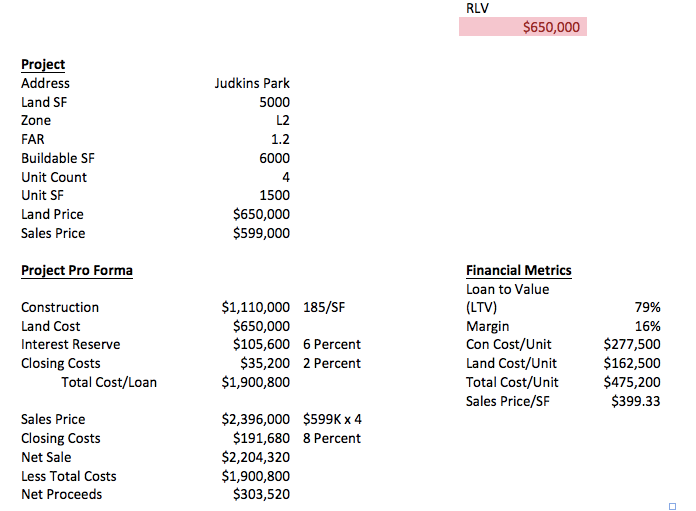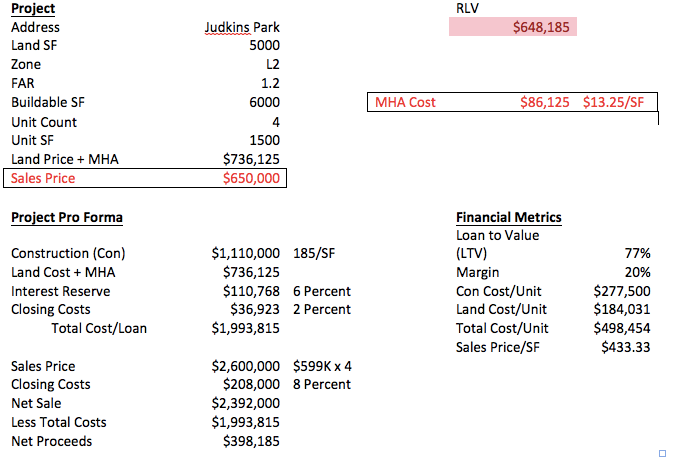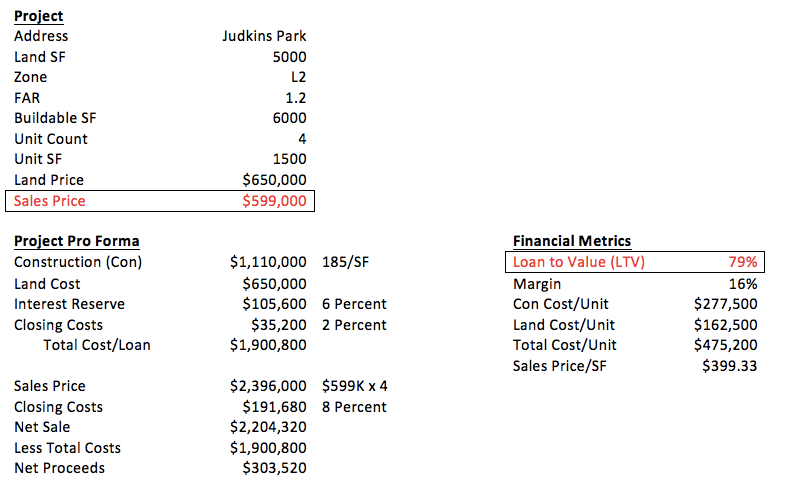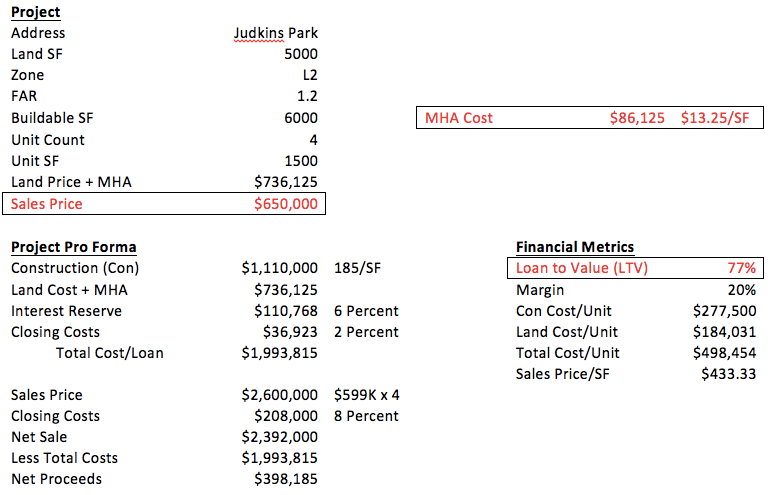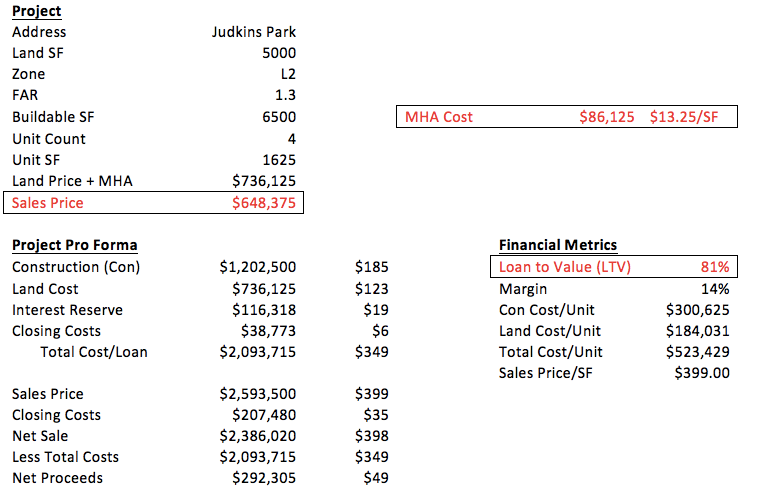Hide and Seek: City’s Consultant Warns Don’t Interpret Residual Land Value “Literally”
The City has stubbornly resisted telling anyone how they intend to implement their version of Mandatory Inclusionary Zoning (MIZ), something they call Mandatory Housing Affordability – Residential (MHA). Some of the furtiveness comes from the fact that City staff are truly making stuff up as they go using guesses and back of the envelope assessments. But last week they finally have revealed the basis upon which they are determining (to their own satisfaction of course) whether their program is feasible. The methodology they are using is called Residual Land Value (RLV) and is almost universally rejected by most who actually build housing as a gauge of financial feasibility (something you’ll later see the consultants agree with). There hasn’t been time to rake through all the numbers, but we can discuss the RLV methodology and why it doesn’t have much use determining feasibility, but does validate the City’s agenda.
The report that I’ll be referring to is the HALA Economic Analysis Summary Memorandum produced by Community Attributes Inc., a company hired by the City. The memo was “requested an economic analysis that evaluates the economic viability of new development with the zoning changes and proposed payment or performance requirements associated with MHA.”
Essentially the memo is supposed to answer the question, “Will MHA work?” Put another way, it would appear to take the questions and objections we have seriously, that inclusion and fees associated with MHA would add costs to projects that would tip them into infeasibility. The question about the impacts of MHA comes from professionals that build housing because they know that the key to getting their projects completed is financing. Every project in town, with very few exceptions, is built with borrowed money. The worry about additional costs has nothing to do with loss of profits but pushing up the cost side to the point where price has to go up, and if prices go up beyond what the market will bear, lenders and investors won’t put their money into a project. I explained this at length in a post about a 4-unit townhouse project. I’ll use that same project here to take a look at RLV.
First, what is RLV and how is it calculated? I’ll use the simple explanation from the memo of how RLV is calculated.
The formula for determining residual land value is: Project value minus costs minus return = RLV.
Here’s how RLV looks when calculated on our Judkins Park project:
You’ll see everything is pretty much the same and the sales price of the land is the same as the calculated RLV. This is because the RLV calculation just isolates what’s left over for land when all other expenses and the margin are accounted for from the sales price. Someone could do the same calculation for Residual Construction Value and that would be the same as the construction total. We’ll see how RLV is being used when we look at our AFTER pro forma.
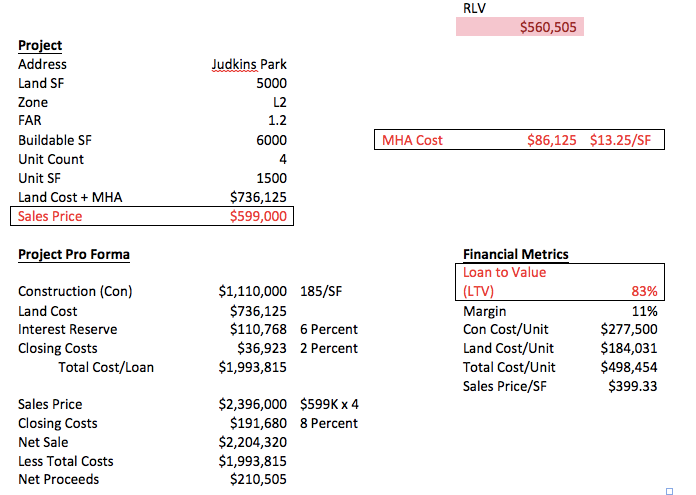 Now, you can see that after the fee is put into the mix, the RLV goes down by about $90,000. Unless some other input changes, our builder won’t have enough money to make the project work. The RLV calculation shows that the fee makes this project infeasible. What if we raise the sales price?
Now, you can see that after the fee is put into the mix, the RLV goes down by about $90,000. Unless some other input changes, our builder won’t have enough money to make the project work. The RLV calculation shows that the fee makes this project infeasible. What if we raise the sales price?
Now the project “works” because the higher sales price has absorbed the fee. The RLV number is just about the asking price of $650,000. But as we’ve pointed out over and over, it makes no sense to squeeze money out of market rate projects in the name of making housing affordable; this won’t happen. Instead the fees will end up just raising housing prices to absorb the extra costs.
The RLV formula is logical. If you were standing on the sidewalk in front of a vacant lot with a “For Sale” sign you could do the math in your head. If I take the cost of construction, financing, and return from the sale of the property and subtract all that from what I could sell four townhomes on the lot, you’d get a number. In theory, that number is what you should or can pay for the land. The price of land is an important component in determining the financial feasibility of a project. But using RLV has its limits.
And no, the fee can’t just “come out of the profits.” Remember the Loan To Value (LTV) ratio? The lender and the investor need that number to be 75 percent or lower. They won’t accept a lower ratio that would result from lowering the margin.
And no, the seller won’t just lower the price of the land $90,000. There isn’t any reason the builder couldn’t or wouldn’t point out the fee before she bought the land, but prices for housing climbing the seller might just put the house that is on the lot for sale as is. Or he might just hold out waiting for someone else who will have a lender willing to boost the price of the townhomes.
The memo issued by the consultant is very accurate and matter of fact about the usefulness of RLV to help understand the impact of the MHA fees and costs of inclusion. But RLV might establish some broad measure of impact on what builders can pay for land after MHA, it doesn’t consider financing requirements or other costs that arise during development like:
- Power line setbacks
- Water/sewer main extensions
- Effective townhome unit width minimums (market driven, not building or LU code)
- Dilution of value for each added floor (i.e. a 3 story 1,400 sf townhome is more valuable than a 4 story 1,400 sf townhome)
And the consultants agree. Here’s what they say, emphasis is mine:
Because of the uncertainty that comes with the hypothetical developments modeled in this analysis, one must take care to not interpret residual land value literally for willingness-to-pay for land. Many other site-specific factors come into play for true willingness-to-play, such as opportunity costs of putting that investment toward other sites that might be more attractive (Page 4).
There has been a stubborn insistence among some advocates and supporters of MIZ generally and MHA in particular that the fees and inclusion will get paid for “out of the land.” That is, when the fees and inclusionary requirements get high enough, land prices will go down exactly in the amount of the fees or lost rent revenue. This view of real estate is what enables some people to support MIZ with a straight face. Prices won’t go up and nobody will lose money but the person who is selling land, and who cares about them anyway, they were just speculating. But even the City’s consultants in the paragraph I just quoted are smart enough to allow for wide variance for “willingness to play,” or pay.
What everyone must understand about MHA is that it won’t lower housing prices it will increase overall housing prices. The consultant is just handing over data. But they acknowledge that data and analysis doesn’t consider financing, the essential ingredient of any housing project (see above). The City has just shrugged and figured either the new homeowner will pay or the landowner will pay. As long as non-profit developers get their pay day, who cares? I’ll close by quoting a paragraph (emphasis mine) the City should listen to but likely won’t.
RLV models provide enough detail and structure to understand major cost and revenue drivers and, because they rely on local market data, they effectively convey information about the types of projects that are more or less feasible in a given area. They also provide an avenue to evaluate and compare feasibility efficiently and across a large number of development typologies and zones. An alternative method is a pro forma cash flow model, which incorporates more detailed financial metrics and investment criteria. When underwriting a specific development, a developer will use a cash flow model to gain an in-depth understanding of the financial performance of a development project. Detailed cash flow models are not necessary, nor particularly well-suited, to answer policy questions at this scale and altitude because they require very detailed assumptions that are likely to be highly variable across different development projects. (Page 4)
Featured image is Hiding in the Haycocks, painted in 1881 by William Bliss Baker.
Has Seattle Reached its Emotional Limit on Growth?
Danny Wesneat has a mixed record on writing about growth in Seattle. His most recent column, “Seattle’s latest growth industry: bemoaning what’s been lost,” has the following paragraph:
But I do wonder: When we’ve taken to memorializing even the loss of our grocery stores, maybe the pace of change has pushed us to some sort of emotional limit?
I think Westneat buried the lede or at least the most important question. As I discussed at Forbes last week, Seattle’s liberal progressive freak out about the election of Donal Trump begs the question: what are you really upset about Seattle?
On Black Friday I ran into a fellow Capitol Hill resident who is an opponent on growth issues. We get along personally and often joke and tease each other about our differing points of view and the ones we share (eg the City is largely annoyed an unresponsive and deaf to criticism from both of us).
Each of us kind of had a hard time understanding how Seattle’s Mayor would make a big show of how Seattle would stand up to Trump, while at the same time using prisoners to sweep homeless encampments. The Mayor and the City Council trip over themselves to wrap themselves in progressive ideology while at the same time promoting policies that limit housing growth and production and crack down on local refugees living in encampments while calling the city a sanctuary.
Knute Berger at Crosscut even wrote a self-congratulatory post about how people terrorized by Donald Trump could come to Seattle. That’s funny if it wasn’t so sad. They’ll have a tough time given the fact that our city’s leaders continue to indulge in rhetoric while enacting policies that ensure housing will just get more expensive and, for those who are homeless, create a hostile environment.
So has Seattle reached its emotional limit? Not yet I guess. Instead Seattle is like a tired child having a meltdown in the grocery store when he can’t get what he wants. Seattle is engaged in a slow motion breakdown, complete with rages and tantrums about growth and change, ugly buildings and tech workers and weepy, nostalgic interludes about one business or another closing down. Perhaps the kicking and screaming and self-pity will burn itself out. But it hasn’t shown signs of abating yet.
Meanwhile, some of us will continue to hold on to the bright side of change (see Bryan Kirschner’s post about prosperity) and urging members of the media to do the same. When you’re all done having your fit, and you dry your eyes, we’ll be here waiting with ideas about how we can increase the production of housing of all kinds, in all parts of the city, for all levels of income including leveraging the progress homeless people have made with encampments. Until then, here’s a box of kleenex.
Again and Again: MIZ Raises Housing Prices to Fund an Inefficient Subsidy System
Here I go again. Mandatory Inclusionary Zoning (MIZ) is an inflationary intervention in the housing market that simply adds what amounts to a unauthorized tax to new housing and commercial space. The money generated from the tax will end up being poured into a grossly inefficient system of subsidized housing production that will create very, very expensive housing with long waiting lists. Renters and owners in non-subsidized housing units will pay for the new and scarce subsidized housing. But sometimes the social critic or writer or advocate has to be repetitive, especially when the people in charge keep repeating the same mistakes.
One of my heroes is Phillip Glass. Glass is a composer and could easily be called a minimalist. While minimalism is not just repetition, many people would say that Glass’ repertoire is, well, repetitive. My college roommate said one piece sounded like people beating on pots and pans. Here’s John von Rhein from the Chicago Tribune describing Glass.
Glass’ musical style is instantly recognizable, with its trademark churning ostinatos, undulating arpeggios and repeating rhythms that morph over various lengths of time atop broad fields of tonal harmony. That style has taken permanent root in our pop-middlebrow sensibility. Glass’ music is now indelibly a part of our cultural lingua franca, just a click away on YouTube.
Minimalism and Glass’ music is kind of like anchovies, cilantro, and Chinese Opera: you either like it or you don’t. The same is kind of true of MIZ, you either like it or you don’t. But it bears repeating, MIZ doesn’t address the broader problem of rising housing prices; in fact, MIZ makes housing more expensive. That in turn will drive the demand from non-profits for more money for more units of subsidized housing. So here’s a reprise of things I’ve written over the years about why raising prices on housing to fund expensive and scarce subsidized housing makes no sense.
MIZ is an unauthorized and inflationary tax. This post was about the linkage tax, something that was set aside in favor of MIZ. But MIZ is just another way to levy a tax on housing to pay for expensive subsidized units. And speaking of rinse-and-repeat, check out what I call the “San Francisco Death Spiral,” the annoying and dangerous tendency to worry about price, impose inflationary rules, fees, and taxes, watch prices rise, then complain about prices, then adding more rules and fees.
http://www.djc.com/news/ae/12071370.html
So all the cash squeezed out of new development will end up going toward non-profit produced housing funded also by Low Income Housing Tax Credits (LIHTC), and subsidies from various other governments and programs. Here’s a post about why it’s so pricey. I’ve pointed out that CHIP’s project, 12th Avenue Arts project cost $47 million for 88 units and El Centro de la Raza’s project on Beacon Hill came in at $45 million for 112 units and a 5 year waiting list. Each of these are beautifully executed projects and will house real people that need housing, but can’t we be more efficient?
http://www.seattleforgrowth.org/why-is-afforable-housing-so-expensive/
If we were more efficient be cutting the undergrowth and accretion of rules, regulations, fees, reviews, process, and delays for housing we’d get more housing; a significant amount of housing. I estimated, conservatively, that we could create about 100 units of housing a year, that’s like one 12th Avenue Arts project each year, just by reducing rules and fees. Here’s a series of posts about this potential, including a study from California I used.
http://www.seattleforgrowth.org/cut-rules-half-create-1960-affordable-housing-units/
SPUR Analysis of Costs
http://www.spur.org/publications/urbanist-article/2014-02-11/real-costs-building-housing
Forbes Post on Costs of Rules
http://www.forbes.com/sites/rogervaldez/2014/10/27/want-more-housing-make-fewer-rules/
The California Study
www.hcd.ca.gov/hpd/docs/FinalAffordableHousingCostStudyReport-with-coverv2.pdf
Here’s a post written by our former intern, Tianyi Xiang, that breaks down some of the factors and variables that contribute to the costs of housing projects.
http://www.seattleforgrowth.org/bricks-mortar-costs-affordable-housing/
And here is my plea that non-profit housing developers band together with us, advocates in the market rate sector, to lower costs. Non-profit housing developers are listened to and believed. They have all the political clout in the housing discussion and policy-making arena. If they pushed hard enough, we could all reap the benefits of lower costs that limit supply and boost prices.
I first discovered the music of Phillip Glass on Thanksgiving Day, 1983 when I was 13 years old and saw Godfrey Reggio’s film Koyaanisqatsi. The film had an enormous impact on me and I went back and saw it several times. Reggio’s purpose was to call out the futility and folly of modern life, that life he argued in images and with Glass’ music, is “life out of balance,” the translation of the Hopi word, koyaanisqatsi.
What Reggio and Glass accomplished, however, was the redemption of that folly by showing how beautiful the folly of life truly is from a distance and perspective. Even in the second film, Powaqquatsi, the opening scene of workers at the Serra Pelada mine in Brazil, the site of environmental degradation and human suffering on a massive scale, ends up being beautiful. Reggio, who trained for years to be a monk, set out to use the rhythm of images and music to distract us from our unhappiness, but ended up, with repetition, also showing us how beautiful we are, even in our suffering. I only wish my blog posts on MIZ could do the same.
The clip I feature is from a segment called Pruitt Igoe. Pruitt Igoe was a large public housing project in Saint Louis that was abandoned and demolished. Pruitt Igoe and other well-known, large, publically owned housing projects were criticized as concentrating poverty. The end of Pruitt Igoe and Cabrini Green marked a shift away from publically owned and operated housing and would be replaced with the Reagan era Low Income Housing Tax Credit program which is a significant source of funding for the non-profit affordable housing industry. I think it’s time to reexamine our abandonment of public housing (I touched a bit on this issue here) in favor of the inefficient system we now have. But that’s a separate post I think.
Take the Survey on Minimum Room and Dwelling Unit Sizes
I’ve been serving on a subcommittee of the Construction Code Advisory Board (CCAB) on smaller living spaces. I know, what’s the CCAB? Well, the CCAB is a hard working group of experts in various fields of construction and building that review changes to the building code. The building code is a powerful way of ensuring basic health and safety. Their role is very different from design review or other committees that look at land use and zoning. The CCAB talks about stairways, elevators, fire exits, and, yes, the size of units and rooms.
You’ll remember David Neiman’s various posts about how new land use regulations and interpretation of the building code have been working together to push up the size of units. As we’ve explained many times before, larger units mean fewer units in buildings. Fewer units means more expensive units since the rent that has to be collected to cover costs has to come from fewer households. It’s just math. Imagine a Thanksgiving meal where the food bill will be shared by everyone at the table. If there are 10 people paying for the same amount of food as 7 people, the costs for the 7 will be higher per person. But wouldn’t they eat less food? Exactly. Lots of people want less space and less rent. Smaller spaces allow that to happen.
What the CCAB is considering is allowing more flexibility in how the building code permits smaller living spaces, in particular units and rooms. The two are distinct. The unit is the whole apartment, while a room is a room inside the apartment. Sometimes, like in my apodment, the two concepts pretty much overlap. In the house where I group up, the unit had three rooms along with baths and separate living rooms. What we’d like to see is lots more flexibility as units get smaller to allow for more, smaller sized units and rooms. This is what people are saying they want, and it’s a great way to create affordable housing units.
So the CCAB is conducting a survey and you ought to participate. Below you’ll see the preamble to the survey and you can get the survey by clicking this link to the Minimum Habitable Space Survey. It will take a bit of time, and feel free get in touch with questions about this. You can email the survey to Jenifer.gilliland@seattle.gov
——————–
Hello,
The City of Seattle is committed to affordable and livable housing. Housing unit size directly impacts affordability and livability. The Seattle Construction Codes Advisory Board (CCAB) is conducting a review of the 2015 Seattle Building Code (SBC) Section 1208 Interior Space Dimensions & Director’s Rule 7-2016 for Small Efficiency Dwelling Units. CCAB has been asked to explore whether Seattle’s approach to minimum room and dwelling unit sizes, dimensions and total area can be more flexible without impacting the health and safety of Seattle residents.
We need your thoughts! A subcommittee of the Seattle Construction Codes Advisory Board is conducting a simple, informal survey to gather information and surface issues and potential options about its current minimum room and dwelling unit size requirements.
You will need to complete this survey in the next few days if you wish your input to be reviewed by the subcommittee. The due date is November 26th at 5:00 pm. Please send all surveys to Jenifer Gilliland at Jenifer.gilliland@seattle.gov. If there is someone else you know that could provide us with valuable information on this topic, please send us their contact information and we will send a survey to them as well.
Thank you in advance for your time!
MIZ Example: No Value Exchange, Just Higher Prices
I’ve been writing about the problems with Mandatory Inclusionary Zoning (MIZ) for a long time now. In short, MIZ is infeasible, inflationary, and most likely illegal. The idea of extracting money to pay for rent restricted housing might be a good political solution but it would add costs that would make some projects infeasible and when they did pencil, it would be because prices would have gone up to offset the financial impact. It’s worth taking a closer look at how the current MIZ creates feasibility problems that can only be improved when the price of housing goes up – if it can.
A 4 Unit Townhouse Project: Before MIZ
The example we have put together is a townhouse project in Judkins Park. Most of the assumptions are in the following table.
The most important number to watch on the table as an indicator of feasibility is the Loan to Value measure or LTV on the far right. Contrary to what some people might think or believe almost every development project in the city is built with borrowed money either from investors putting in cash with an expectation of a return payment or a bank that is charging interest. No matter where the money is coming from, there is always a measure of the debt to the value of the project.
In the case of multifamily housing projects financing over a period of years, this is usually called a Debt to Credit Ratio or a DCR and in townhouse or single-family projects an LTV. A DCR is usually expressed using decimals with an optimal DCR being around 1.20. Roughly, this means that for every dollar borrowed, the project must produce at least $1.20 in income to cover the operations of the project and the debt service. In a for sale product, the LTV is an indictor of the coverage of the borrowed money compared to the anticipated value of the sale at closing. An optimal LTV would be about 80 percent. As the LTV goes higher, lenders and investors are unlikely to provide funding, since for them it is a measure of risk. The lower the LTV, the more likely the project will produce the required return on investment.
This project currently is meeting that minimal expectation with a unit sale price of $599,000. It’s important to understand that the lender or investor also sets the price based on what they believe the market will bear. If the LTV is 65 percent, but the price of the product seems way too high, the lender will push back and demand a lower sales price. In other words, the bank might not believe that this particular product, in this neighborhood will get $599,000. If that’s the case the project won’t happen. Other options are to find ways to lower costs.
Every development project goes through this feasibility phase in which costs, the market price, and the potential return and risk are all vetted and discussed. Every party in the transaction wants to be sure that at the end of the 12-month period, they’ll be able to walk away with a return on the investment that justifies the risk. If there isn’t any confidence in this, the project won’t get beyond this phase, the land won’t be purchased, contracts won’t be put out for bid, and whatever sits on that 5000SF lot will remain.
A 4 Unit Townhouse Project: After MIZ
So what happens to this project when MIZ is imposed?
The assumptions for this project includes that it is in an area designated as “Low” under the MIZ requirements imposed by the Mayor’s Mandatory Housing Affordability (MHA) legislation. The “Low” designation indicates areas deemed to have low rents or lower priced housing. However, after the Mayor got together with Councilmember Lisa Herbold several weeks ago to devise a Displacement Index that would boost the fees and inclusion rates in those areas (supposedly to avoid “displacement” created by new housing, this project is now in a “Medium” area.
The Medium-MHA geographic area is expanded to include formerly Low-MHA areas: North Beacon Hill, North Rainier, and Columbia City, Northgate, and Crown Hill. Development in these areas will be subject to MHA Medium amounts that range from 6% to 10%. These changes increase the area citywide where high and medium MHA payment and performance amounts apply.
So what happens to the project when it pays $13.25 a square foot for the in lieu fee (and remember builders pay for additional square feet whether they use it or not, and here that’s 500 SF or about $6000)?
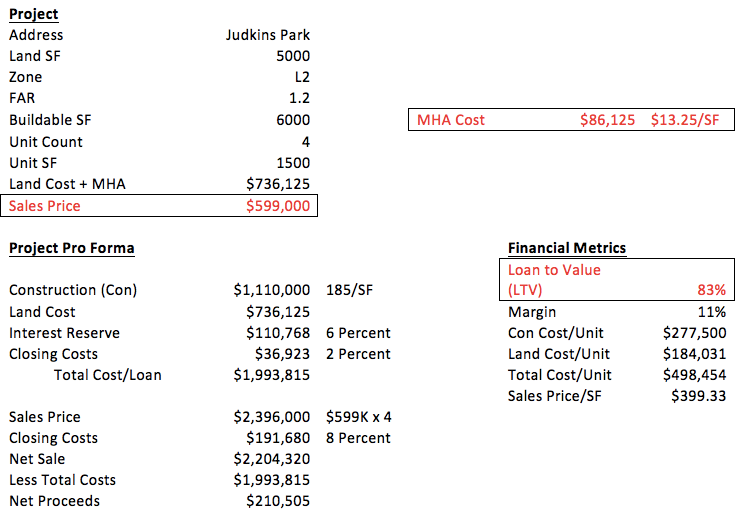
It’s important to note that the builder said this about the additional square footage that comes along with the MHA program:
I would not build the additional [square footage] granted by MHA in this project. It doesn’t make financial sense to build the additional SF. You would have to build a fourth floor and the market doesn’t like fourth floors and wont pay the normal sales per SF for a 4th floor.
Also keep in mind that the additional construction costs for the fourth floor if it was built would also add costs to the project. I’m not going to do the math all the way through here, but building the additional square footage would add to the sales price of the unit and to the loan amount, but there would also be some additional expense. However, the builder of this project says people (the market is people after all) aren’t buying 4 story townhouses.
But just as important, notice the change in the LTV; it’s now at 80 percent. That change means banks or investors won’t provide the needed capital for the project, so the project won’t happen. What the builder can do is find additional sources of funding to cover the new costs. He could also find a way to lower construction costs or he could find another lender willing to take more risk.
But what is the most likely scenario? The price for the units will increase, provided people looking for homes are willing to pay more for this product in this neighborhood.
There you have it. Fees imposed will either slow production by putting projects out of feasibility or prices for housing will go up to absorb the additional costs, provided people can and will pay the higher prices.
Let’s look at one more possibility. What if the builder used the additional 500 square feet granted for the fees being charged?
The additional “bonus” square footage offered by the City’s MIZ proposal doesn’t help very much even if it can be used on the site and without the price boost, actually lowers the per square foot sales price ($399) if the price stays the same, $599,000. Instead, in this case, those extra square feet have to be offset with an additional $50,000 on the price and the LTV is still too high. As I’ve said before, the City’s MIZ program is not a value exchange program but an exaction. What happens in this example is either nothing when the project doesn’t pencil, the price of the housing goes up to make it work, and even when the additional FAR is factored in, it doesn’t produce much vale for the hassles and costs associated with it.
There a many other lenses to view this example, including the City’s argument and assumption that the price of the land would go down exactly as much as the fee. We can argue about that all day, but what I hear from people who make housing is that this simply won’t happen, and if it did, the owner of the land with a single-family house in this zone would just sell it to someone who wants to live in it, not for development. That means a loss to the market of 4 houses; and, importantly, $0 in fees for the City.
Finally, this example is for discussion. Each and every project will have different up sides and down sides. But what we know doesn’t help production is additional costs and process. What will happen isn’t so much that builders will discover this impact as they build, but the new fees will get baked in essentially to production. Housing production will go on once prices go up enough to simply include the fee in the cost of doing business. This same scenario will play out with other kinds of housing too, including apartments. That’s not a good solution for people who say we’re having an affordability crisis in housing. It’s time to reconsider this intervention and exchange it for one that would have a beneficial impact on price.

